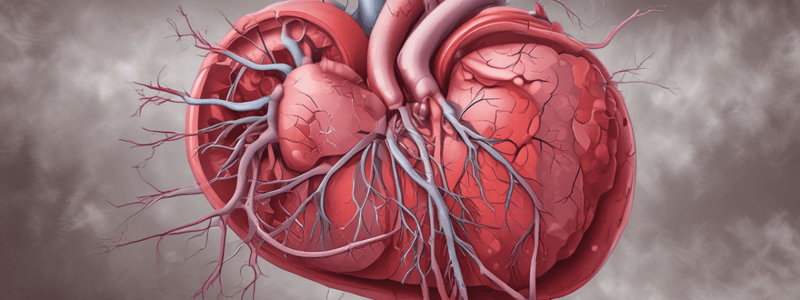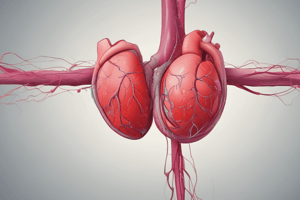Podcast
Questions and Answers
What is a significant complication of DVTs?
What is a significant complication of DVTs?
Pulmonary embolism (PE)
What is one of the three elements of Virchow's Triad?
What is one of the three elements of Virchow's Triad?
Stasis
What is a condition that increases the risk of DVTs?
What is a condition that increases the risk of DVTs?
Pregnancy
What is a type of pharmaceutical that can be used to prevent DVTs?
What is a type of pharmaceutical that can be used to prevent DVTs?
What is the difference between a thrombus and an embolus?
What is the difference between a thrombus and an embolus?
What imaging techniques are used to diagnose VTE?
What imaging techniques are used to diagnose VTE?
What blood tests are conducted to investigate VTE?
What blood tests are conducted to investigate VTE?
What are the common anticoagulation medications used to treat VTE?
What are the common anticoagulation medications used to treat VTE?
Which artery supplies the stomach, duodenum, liver, pancreas, and spleen?
Which artery supplies the stomach, duodenum, liver, pancreas, and spleen?
What type of aneurysm is characterized by dilation of the entire circumference?
What type of aneurysm is characterized by dilation of the entire circumference?
Which artery supplies the pancreas, small bowel, and proximal large bowel?
Which artery supplies the pancreas, small bowel, and proximal large bowel?
What is the characteristic feature of a saccular aneurysm?
What is the characteristic feature of a saccular aneurysm?
What is a dissecting aneurysm also known as?
What is a dissecting aneurysm also known as?
What is a risk factor for developing an aortic aneurysm?
What is a risk factor for developing an aortic aneurysm?
What is a risk factor for rupture of an aortic aneurysm?
What is a risk factor for rupture of an aortic aneurysm?
What is the surgical threshold for abdominal aortic aneurysms in males?
What is the surgical threshold for abdominal aortic aneurysms in males?
What is the surgical threshold for abdominal aortic aneurysms in females?
What is the surgical threshold for abdominal aortic aneurysms in females?
What are the determining factors of the signs and symptoms of an aortic aneurysm?
What are the determining factors of the signs and symptoms of an aortic aneurysm?
What is a common diagnostic test used to investigate an aortic aneurysm?
What is a common diagnostic test used to investigate an aortic aneurysm?
What is an important consideration in the management of an aortic aneurysm emergency?
What is an important consideration in the management of an aortic aneurysm emergency?
What are the characteristic symptoms of acute limb ischemia?
What are the characteristic symptoms of acute limb ischemia?
What diagnostic investigations are used to diagnose acute limb ischemia?
What diagnostic investigations are used to diagnose acute limb ischemia?
What are the key components of management in acute limb ischemia?
What are the key components of management in acute limb ischemia?
Virchow's Triad
Virchow's Triad
what assessment can help assess the probability of VTE
what assessment can help assess the probability of VTE
Aortic Perfusion
Aortic Perfusion
Aortic Aneurysm management
Aortic Aneurysm management
Flashcards are hidden until you start studying
Study Notes
DVTs and Pulmonary Embolism
- DVTs can lead to pulmonary embolism (PE), a significant cause of mortality
- Stasis, endothelial injury/dysfunction, and hypercoagulability are risk factors for DVTs
Risk Factors for DVTs (Virchow's Triad)
- Stasis: Prolonged immobilization
- Endothelial injury/dysfunction: Surgical procedures, lipid/cholesterol plaque formation
- Hypercoagulability: Pregnancy, diabetes, and other conditions
Investigations for DVTs
- Bloodwork: FBC, coagulation studies, liver and kidney function, electrolytes, D-dimer
- Imaging: Doppler ultrasound, chest imaging (CTPA or V/Q scan)
Treatment for DVTs
- Anticoagulation: Low molecular weight heparin, intravenous unfractionated heparin, warfarin
- Outpatient management is possible for acute DVT in selected patients
Aortic Anatomy and Aneurysms
- Subclavian and carotid arteries supply the arms and brain
- Celiac trunk supplies the stomach, duodenum, liver, pancreas, and spleen
- Superior mesenteric artery supplies the pancreas, small bowel, and proximal large bowel
- Renal arteries supply the kidneys
- Inferior mesenteric artery supplies the distal large bowel
Types of Aortic Aneurysms
- Fusiform: Dilation of the entire circumference
- Saccular: A portion of the artery is dilated (sac-like appearance)
- Dissecting (pseudoaneurysm): Dissection of the intimal layer creating a false channel or lumen
Risk Factors for Developing Aneurysms
- Atherosclerosis, connective tissue diseases, prior aortic dissection, infection, aortic valve disease, prior aortic surgery, diabetes, heredity, male gender, and age
Risk Factors for Rupture
- Large initial aneurysm diameter, current smoking, elevated blood pressure, higher aortic expansion rate, female sex, and presence of symptoms
Abdominal Aortic Aneurysms (AAA)
- Rare under 50 years of age
- Prevalence rates estimated at 1.3-8.9% in men and 1.0-2.2% in women
- Surgical threshold is 5.5 cm for males and 5.0 cm for females
Aortic Aneurysm Symptoms
- Severe pain (tearing, sharp, ripping)
- Collapse, pulsatile mass, back pain, abdominal pain, cough, dyspnea, stridor, tachycardia, unilateral absence of major pulses, bilateral blood pressure differences, hypertension, hemiplegia, and ischemic limbs
Investigations for Aortic Aneurysms
- Chest X-ray, MRI, CT scan with contrast, ultrasound, transesophageal echocardiogram, and angiogram
Management of Vascular Emergencies
- Oxygen, large bore IV access, analgesia, tight blood pressure control, treatment of hypovolemic shock, and urine output monitoring
- Damage limitation: Vasodilator therapy, identify and treat the cause, maintain limb position below heart level, analgesia, intravenous thrombolytics, anticoagulation, and surgical intervention
Studying That Suits You
Use AI to generate personalized quizzes and flashcards to suit your learning preferences.



